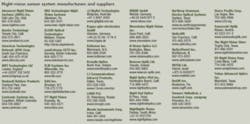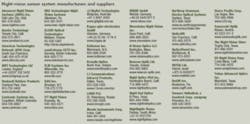By John Keller
Night-vision equipment represents one of the crucial capabilities that help the U.S. military own the night when engaging the enemy, yet digital technology and multispectral imaging are on the verge of giving fighting forces an even keener edge while operating under the cover of darkness.
Emerging digital night-vision devices have the potential not only to improve image quality, pull out important details from clutter, and reduce size, weight, and cost, but also to help network images from night-vision equipment in real time to improve situational awareness in the fast tempo of the digital battlefield.
Night-vision devices common on the battlefield today involve so-called Generation 1, 2, and 3 analog technology of various qualities that use photocathode tubes that multiply electrons and light to enhance and brighten otherwise dark images.
While Generation 1 is the most simple and inexpensive of the available night-vision devices, Generation 2 incorporates a microchannel plate with the photo- cathode tube to further multiply electrons and produce better image resolution than Generation 1, explains Tom Horwath, product line manager for image-intensified systems at Night Vision Systems, a DRS Technologies company in Allentown, Pa.
Generation 3 night-vision devices-currently the best of the widely fielded devices-add a gallium arsenide photo-cathode “to increase the photo response of the unit, produce a higher response, and make the image a lot brighter and clearer,” Horwath says.
The next improvement in analog night-vision devices involves thinning or eliminating the ion film barrier on the microchannel plate. This barrier originally was included to increase the life of the tube.
“Remove the coating and the performance of the tube goes up, but possibly it may decrease the life of the tube,” Horwath says. “The image tubes have gotten pretty good, and I’m not sure how much increase you will see in the future.”
On the horizon, however, are digital night-vision devices, which “will allow for a reduction in cost, and allow a lot more integration,” says David Miles, national sales manager at Yukon Advanced Optics Inc. in Mansfield, Texas.
“A digital night-vision goggle possibly could be wirelessly hooked up to a command center 10 miles away to allow commanders to see what the soldier is looking at,” Miles says. “That application is a ways off, but is what people are asking for.”
Long term, digital night-vision technology is likely to render analog technology obsolete-“but not in the next couple of years,” Miles says. “Right now you are talking traditional night vision and incorporating it into day/night systems.”
Users of night-vision systems demand levels of quality that depend on the application, points out Dmitry Postovalov, sales manager for law enforcement at Advanced Night Vision Systems Inc. in Salt Lake City.
“There is a big gap between military and law enforcement,” he says. “The military demands a high grade of night vision that is versatile and can be merged with thermal-imaging devices-something that can be integrated with head-up displays, range finders, and night-sighting capability. Law-enforcement guys pretty much want small, compact night-vision devices that they can put in the patrol car as part of their duty gear.”
The next big development will be multispectral technology that blends imagery from different sensors to enhance performance. “The trend is to take different sensors and technologies and fuse them together in the same system, such as fusing together an image-intensified tube and a thermal focal-plane array in the same scene,” Horwath says.
Blending sensors makes sense because of the inherent shortfall that each night-vision sensor has while working individually.
The image-intensified system does not see well through smoke, fog, and dust, Horwath says. Infrared thermal imagers, on the other hand, might see through the dust, but not have the resolution of the image intensifier.
“It might be difficult to see someone hiding behind a bush 200 yards away,” Miles explains. “You might not be able to see him with image-intensified night vision only, but with thermal you could see the heat signature.”
Fusing imagery from the different sensors “kind of gives you the best of both worlds,” Horwath says. Blending analog night-vision sensors involves overlay technology, which enables the devices to mechanically blend imagery from both sensors. “You get the best of both sensors, but you get everything from both sensors,” he explains.
The coming digital era in night-vision devices will make multispectral systems even better. “With digital fusion you can go pixel-by-pixel and pick out the best parts of each sensor based on algorithms written for the image processor that conducts the fusion,” Horwath says.
null




